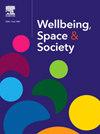Exploring the impact of urban green spaces on behavioral and psychological well-being: Based on the context of urban villages and ordinary neighborhoods in Shenzhen, China
IF 2.2
Q2 GEOGRAPHY
引用次数: 0
Abstract
With the acceleration of urbanization, the impact of urban green space (UGS) on public health has received increasing attention. The aim of this study is to investigate the behavioral and psychological impacts of UGS use on residents of urban village areas (UVAs) and ordinary residential areas (ORAs) in Shenzhen from different economic backgrounds. A quantitative survey of 184 ORA residents and 205 UVA residents was conducted. We analyzed the relationships of the frequency of green space use, the duration of green space use, the level of activity participation, and social interaction with residents’ health status. Significant correlations were found between the use of UGSs and residents’ living environment, social characteristics and physical and mental health. Residents of ORAs not only accessed green spaces more frequently and for longer periods, but also exhibited more stable physical and mental health profiles than their UVA counterparts. Structural-equation modelling revealed two partially mediated pathways: 1) higher use frequency bolstered social networks, which in turn improved mental health; 2) greater activity participation was associated with higher blood-oxygen saturation. Crucially, these pathways were significantly attenuated among UVA residents, underscoring how deficits in green-space availability, quality and perceived safety erode health benefits. By highlighting these differences, the study provides planners with evidence-based strategies to promote environmental justice and health equity in China's rapid urbanization process.
探索城市绿地对行为和心理健康的影响——基于深圳城中村和普通社区的背景
随着城市化进程的加快,城市绿地对公众健康的影响日益受到人们的关注。本研究旨在探讨不同经济背景的深圳市城中村和普通居民使用UGS的行为和心理影响。对184名ORA居民和205名UVA居民进行了定量调查。我们分析了绿地使用频率、绿地使用持续时间、活动参与水平和社会互动与居民健康状况的关系。居民的生活环境、社会特征、身心健康状况与UGSs的使用存在显著相关。与UVA的居民相比,ora的居民不仅更频繁、更长时间地使用绿地,而且表现出更稳定的身心健康状况。结构方程模型揭示了两个部分介导的途径:1)更高的使用频率加强了社交网络,从而改善了心理健康;2)更多的活动参与与更高的血氧饱和度相关。至关重要的是,这些途径在弗吉尼亚大学居民中显着减弱,强调了绿色空间可用性,质量和感知安全性的缺陷如何侵蚀健康效益。通过强调这些差异,该研究为规划者提供了基于证据的策略,以促进中国快速城市化进程中的环境正义和健康公平。
本文章由计算机程序翻译,如有差异,请以英文原文为准。
求助全文
约1分钟内获得全文
求助全文
来源期刊

Wellbeing Space and Society
Social Sciences-Social Sciences (miscellaneous)
CiteScore
2.70
自引率
0.00%
发文量
46
审稿时长
124 days
 求助内容:
求助内容: 应助结果提醒方式:
应助结果提醒方式:


